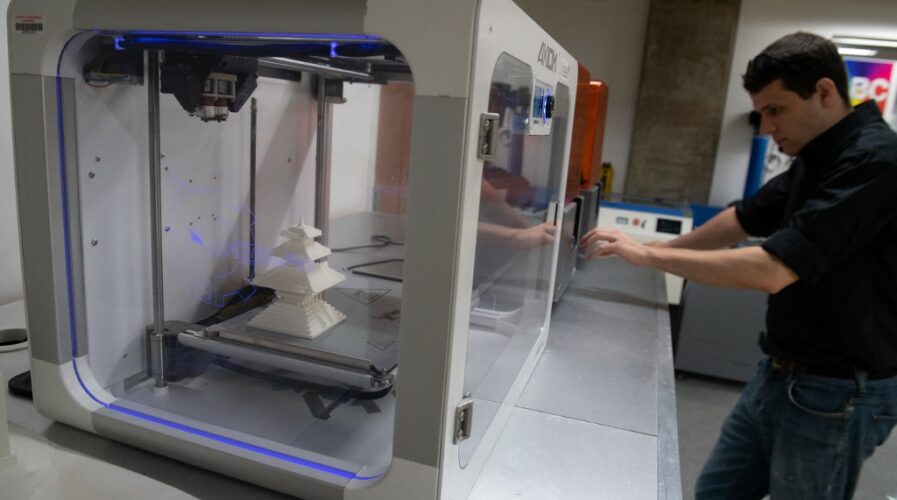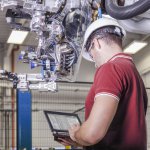
Both conceptualizing and problem-solving can be improved with a digital twin. Can it enhance the workplace? (Photo by SAUL LOEB / AFP)
Is digital twinning the solution to providing a better workplace
Digital twinning is a concept that is gaining momentum across many industries, notably engineering and related fields where digital replicas of real-world infrastructure could have tangible benefits. As businesses globally including many in Asia grapple with the logistics of switching their operations from the office to remote locations, employers have been forced to question if workspaces are ideal enough for modern workforces. Can digital twins help?
An industry valued at USD$3.8 billion, the global digital twin market is set to reach USD $35.8bn by 2025. So what is a digital twin? Digital twinning is a lot like what it sounds like: a virtually replicated digital dummy that is designed to be identical to a process or product within a physical environment.
Essentially, it consolidates data from various sources, alongside data gathered by IoT sensors, and creates a contextual model of the physical object in the built environment. Such a model can provide businesses with unparalleled insights.
The health of the built environment can be tracked and analyzed, allowing businesses to play defense, anticipating and rectifying potential issues even before they happen in the real world. Digital twins are often used to optimize visualization and subsequently improve performances, and one way this is done is by creating a better workplace for employees.
Insights on building operations
Business leaders are not on the ground all the time, and can have limited knowledge of their employee’s interactions and sentiment towards the office space. This information is crucial, as it has a direct bearing on how company resources are being used.
Unnecessary costs can be incurred, for example, when the lights and electronic equipment in an empty boardroom are left on for long hours. A digital twin can be a solution to this, as one of its main applications is rendering buildings and all the rooms and fixtures contained inside, down to the door handles.
Via data gathered from sensors and analytical tools, digital twins can present a panoramic view of how and when space is being used, in real-time and often in three dimensions. Armed with this knowledge, employers can ascertain if there is a need to scale resources, or to engage services such as cleaning or security.
Digital twinning uses data to drive biz decisions
Data is all around us. However, data will only be just that – data, if it is not harnessed in a way that can be operationalized. Often, businesses miss out on valuable insights because the data is not readily visible, hidden in places that are often overlooked.
With digital twins providing a holistic view of a building, all actionable data can be captured. This allows leaders to make better business decisions on a broad array of issues that would impact both the bottom line and employees.
For example, instead of using a static model, employers can employ cleaning services on a demand-based model that matches supply with changing needs.

A 3D printed, digital exact twin copy made of acrylic resin covered with marble dust to replicate Michelangelo’s iconic David statue. (Photo by Carlo BRESSAN / AFP)
Enhance employee experience
With thousands of occupants in a building, employee experience remains a challenge for many building managers. Having to respond to disruptive instances such as preset ‘lights-out’ times or switching off the centralized air conditioning can be a nuisance, and a significant source of dissatisfaction for employees.
With digital twins bringing in data about changing conditions, building managers can instead visualize, anticipate, and fix problems in real-time. Identifying and rectifying issues would no longer be a frustrating process for building staff and employees, allowing them to focus on value-added work.
With all that digital twinning provides, business leaders would be wise to embrace the concept now. In just a short time the tech is seeing a wide range of applications, starting in manufacturing and smart city development, is changing supply chains, and even in museum restorations.
It must also be noted that like any other technology, complete success will only come through collaboration. Therefore, governments must drive national policy in creating shared ecosystems, and industrial leaders should get out of silos, learn from one another, and push for industry standardization and acceptance of digital twins as assets not just to businesses, but even their workplaces.
READ MORE
- Safer Automation: How Sophic and Firmus Succeeded in Malaysia with MDEC’s Support
- Privilege granted, not gained: Intelligent authorization for enhanced infrastructure productivity
- Low-Code produces the Proof-of-Possibilities
- New Wearables Enable Staff to Work Faster and Safer
- Experts weigh in on Oracle’s departure from adland


